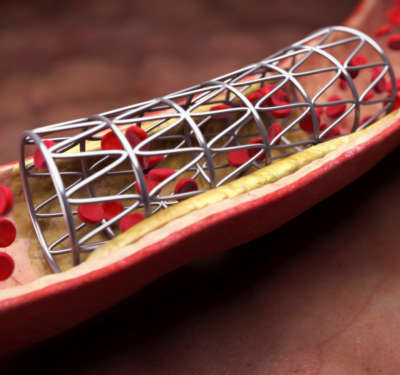Bridging the gaps for heart attack sufferers
Patients with a serious form of heart attack could benefit from opening up heart vessels not involved in the attack.
Published online 30 May 2016

Close-up view of a coronary stent.
© The Science Picture Company / Alamy Stock Photo
ST Segment Elevation Myocardial Infarction (STEMI) is a serious type of heart attack caused by occlusion to one of the major blood vessels that supply the heart. This occlusion leads to death of heart tissue, known as infarction, and can be fatal. People suffering from this form of heart attack are treated by inserting a catheter through a vein in the leg that is pushed up to the occluded heart vessel, opening it by inflating a balloon then leaving a “stent” which acts like a bridge that keeps the vessel open.
About half of patients presenting with STEMI also have other diseased vessels in the heart, leading to higher death rates and greater incidence of re-infarction compared to patients with a single occluded vessel. Doctors are often uncertain about the best way to treat STEMI patients with multivessel disease.
A team of doctors from Egypt’s Aswan Heart Center and Italy’s Careggi Hospital reviewed the results of recent treatment trials conducted in the UK and Denmark on STEMI patients1. Previous research showed conflicting evidence about the benefits of treating STEMI patients with multivessel disease applying one of three procedures. The first involves only opening the occluded vessel causing the current infarction. The second involves opening the occluded vessel, then conducting a second procedure that opens up other diseased vessels before the patient is released from hospital. The third involves opening the main occluded and other diseased vessels during the same procedure.
Despite some weaknesses in how the trials were conducted, the team found that, overall, opening the occluded artery in one procedure followed by other diseased arteries in a subsequent procedure seemed to provide the best clinical outcome for patients with STEMI and multivessel disease. On the basis of the findings from these trials, three different cardiologist societies have updated their recommendations for the treatment of STEMI patients with multivessel disease, indicating that physicians might want to consider also treating the diseased vessels in some patients based on individual evaluations. The previous recommendation was that this procedure was not useful.
Further research is still needed and the benefits of treating non-infarct-causing diseased vessels need to be weighed against the risks, write the researchers in their review published in the journal Global Cardiology Science & Practice. Although opening up diseased vessels may prevent recurring infarction, it also exposes patients to risks. Stents can cause the formation of potentially fatal blood clots. Patients with stents need to take drugs to prevent clot formation. Patients who undergo the procedure to open up more than one artery are also exposed to contrast agents that may adversely affect the kidneys. Contrast agents are used to help cardiologists see the catheter as it travels along the vessels during the procedure.
“There is growing evidence that complete revascularization during the index admission in patients with STEMI and multivessel disease reduces the risk of future events,” write the researchers. Larger randomized studies are needed, however, to substantiate this.
Reference
Hassan, A., ElGuindy, A. & Antoniucci, D. Culprit lesion-only versus complete revascularization in patients with STEMI: lessons learned from PRAMI, CvLPRIT, and DANAMI-3 PRIMULTI. Glob. Cardiol. Sci. Practice 2015, 60 (2015). | article
DOI: 10.1038/qsh.2016.113

